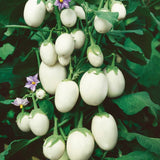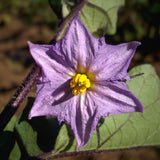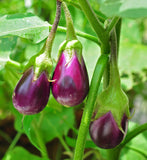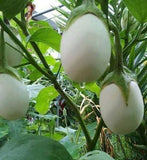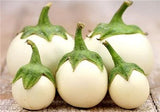Solanum melongena Seeds – “Midnight Jewels of the Silk Road”
Step into a garden where history blooms in glossy purple and twilight-blue. Solanum melongena, proudly known as eggplant, aubergine, or brinjal, carries tales of ancient trade routes, royal tables, and shimmering culinary artistry. These seeds promise more than fruit—they offer a living tapestry of cultures, pollinators, and midnight-hued magic.
1. Cultural Splendor & Historical Roots
Born in South and possibly Southeast Asia, eggplant’s earliest mention dates back to 59 BCE in Chinese literature. It later journeyed to Europe via the Iberian Peninsula in the early Middle Ages, weaving into Moorish and Mediterranean food traditions. In folklore, it symbolized protection, good health, fertility, and even prosperity—a mystical heirloom from distant lands. Over time, it morphed into a symbol of culinary prestige in medieval Europe.
2. A Bloom of Purple Stardust
When these seedlings mature, expect charming star-shaped blossoms in soft violet or lavender hues. Amid lush, velvety foliage and prickly stems, these delicate flowers hint at the regal fruit to come.
3. USDA Hardiness & Growing Rhythm
Eggplant thrives best in USDA Zones 9a through 12b, relishing warmth and abundant summer sunlight. In more temperate zones, think of it as an annual or container companion under careful sunny curation.
4. Fragrance & Pollinator Intrigue
Though Solanum melongena isn’t known for fragrance, its pale purple flowers are a treasure trove for pollinators—especially “buzz-pollinating” bees. These industrious visitors vibrate the anthers to release pollen, enriching fruit and seed set.
Greenhouse inhabitants like stingless bees (Melipona fasciculata) and wild Xylocopa and Amegilla bees have proven themselves stellar pollinators, turning blooms into bountiful harvests.
In the wild across Kenya, native solitary bees like Xylocopa caffra and Macronomia rufipes help sustain local eggplant pollination, especially in mosaic landscapes.
Bumblebees are also frequent flower admirers—even if they don’t buzz, their presence supports pollination in home gardens.
5. Intriguing Tidbits & Practical Magic
-
Buzz Pollination Enhances Yield: Fruits from bee-visited blossoms are richer in seeds and more consistent, while self-pollinated or bagged flowers produce fewer seeds despite similar fruit size.
-
Botanical Grace: Eggplant often sprouts to 2–4 ft tall, branching elegantly under summer sun. Its leaves and stems sport star-shaped hairs—a subtle reminder of its nightshade kin.
-
Culinary Palette: The glossy fruits come in shades of deep purple, green, white, yellow, gold, and even lavender—each a culinary canvas ready for roasting, grilling, stuffing, or stewing.
Product Summary — Why These Seeds Are Enchanting
| Feature | Delightful Details |
|---|---|
| Culinary Legacy | Ancient Asian origin, Mediterranean journeys—rich in folklore and symbolism. |
| Bloom Hues | Soft violet, star-shaped flowers—a mystical prelude to fruit. |
| Hardiness Zones | USDA 9a–12b; treat as annual in cooler regions or grow in containers. |
| Pollinator Support | Especially loved by buzz-pollinating bees—ideal for vibrant, productive gardens. |
| Growth Form | Multi-branched, 2–4 ft tall perennial in warm climates; annual elsewhere. |
| Fruit Variety | Shades from purple to yellow; glossy and elegant—perfect for the plate and the eye. |
| Garden Lore | A symbol of protection, fertility, and status across cultures—more than just a veggie! |
Gardening Tips to Bring the Midnight Jewels to Life
-
Start Indoors: Sow early under warmth; seedlings love 70–85°F.
-
Full‑Sun Feast: Set out in space that basks in sun for 6–8 hours daily.
-
Pollinator-Friendly: Encourage buzz bees—plant clover, borage, or other pollen-rich allies nearby.
-
Harvest Timing: Pick the fruit while smooth and glossy—when the seeds are still tender and succulent.
-
Companion Ponder: Avoid planting near other nightshades like tomatoes or potatoes—they share pests and compete for nutrients.
Sow these seeds and conjure a living narrative in your garden—one where culinary richness, ancient myth, and buzzing life intertwine. If you’d like suggestions on companion plants, container setups, or attracting specific pollinators, I’m happy to help your garden story resonate even more.






